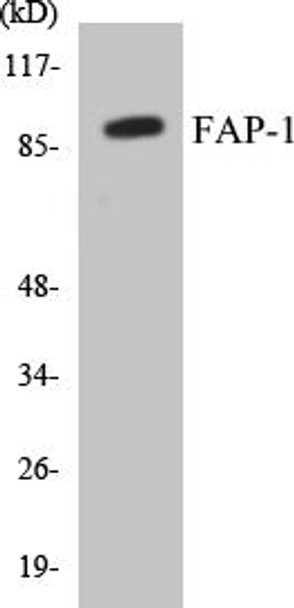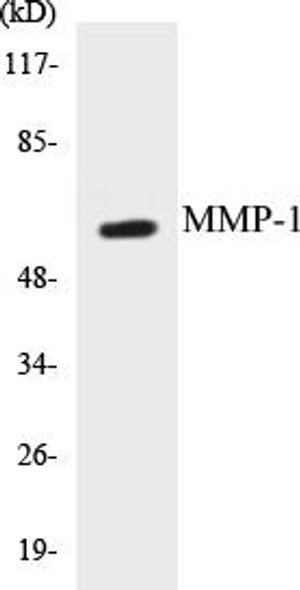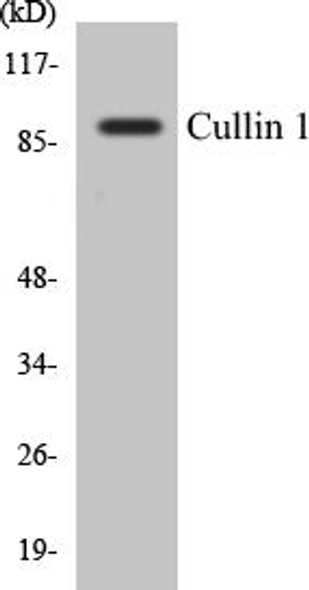Description
FAP-1 Colorimetric Cell-Based ELISA Kit
The FAP-1 Colorimetric Cell-Based ELISA Kit is a powerful tool for researchers studying the Fas-associated phosphatase-1 (FAP-1) protein in cell culture samples. This kit offers high sensitivity and specificity, allowing for accurate detection of FAP-1 levels in various cell types.FAP-1 is an important regulator of apoptosis and cell signaling pathways, making it a key player in cancer research and drug development. By accurately measuring FAP-1 levels in cell culture supernatants, researchers can gain valuable insights into the mechanisms underlying cell death and survival, as well as potential therapeutic targets for cancer treatment.
With its reliable and reproducible results, the FAP-1 Colorimetric Cell-Based ELISA Kit is an essential tool for scientists working in the fields of oncology, cell biology, and drug discovery. Invest in this kit today to advance your research and uncover new possibilities in the study of FAP-1 signaling pathways.
| Product Name: | FAP-1 Colorimetric Cell-Based ELISA |
| Product Code: | CBCAB00299 |
| ELISA Type: | Cell-Based |
| Target: | FAP-1 |
| Reactivity: | Human, Mouse, Rat |
| Dynamic Range: | > 5000 Cells |
| Detection Method: | Colorimetric 450 nmStorage/Stability:4°C/6 Months |
| Format: | 96-Well Microplate |
The FAP-1 Colorimetric Cell-Based ELISA Kit is a convenient, lysate-free, high throughput and sensitive assay kit that can detect FAP-1 protein expression profile in cells. The kit can be used for measuring the relative amounts of FAP-1 in cultured cells as well as screening for the effects that various treatments, inhibitors (ie siRNA or chemicals), or activators have on FAP-1.
Qualitative determination of FAP-1 concentration is achieved by an indirect ELISA format. In essence, FAP-1 is captured by FAP-1-specific primary antibodies while the HRP-conjugated secondary antibodies bind the Fc region of the primary antibody. Through this binding, the HRP enzyme conjugated to the secondary antibody can catalyze a colorimetric reaction upon substrate addition. Due to the qualitative nature of the Cell-Based ELISA, multiple normalization methods are needed:
| 1. | A monoclonal antibody specific for human GAPDH is included to serve as an internal positive control in normalizing the target absorbance values. |
| 2. | Following the colorimetric measurement of HRP activity via substrate addition, the Crystal Violet whole-cell staining method may be used to determine cell density. After staining, the results can be analysed by normalizing the absorbance values to cell amounts, by which the plating difference can be adjusted. |
| Database Information: | Gene ID: 2191, UniProt ID: Q12884, OMIM: 600403, Unigene: Hs.654370 |
| Gene Symbol: | FAP |
| Sub Type: | None |
| UniProt Protein Function: | FAP: In association with DPP4 is involved in the pericellular proteolysis of the extracellular matrix (ECM), the migration and invasion of endothelial cells into the ECM. May have a role in tissue remodeling during development and wound healing, and may contribute to invasiveness in malignant cancers. Belongs to the peptidase S9B family. 2 isoforms of the human protein are produced by alternative splicing. |
| UniProt Protein Details: | Protein type:EC 3.4.14.5; Protease; EC 3.4.21.26; Membrane protein, integral Chromosomal Location of Human Ortholog: 2q23 Cellular Component: apical part of cell; cell surface; cytoplasm; extracellular space; focal adhesion; integral to membrane; lamellipodium; plasma membrane Molecular Function:dipeptidyl-peptidase activity; endopeptidase activity; integrin binding; metalloendopeptidase activity; peptidase activity; protease binding; protein binding; protein dimerization activity; protein homodimerization activity; serine-type endopeptidase activity; serine-type peptidase activity Biological Process: angiogenesis; cell adhesion; endothelial cell migration; proteolysis; proteolysis involved in cellular protein catabolic process; regulation of fibrinolysis |
| NCBI Summary: | The protein encoded by this gene is a homodimeric integral membrane gelatinase belonging to the serine protease family. It is selectively expressed in reactive stromal fibroblasts of epithelial cancers, granulation tissue of healing wounds, and malignant cells of bone and soft tissue sarcomas. This protein is thought to be involved in the control of fibroblast growth or epithelial-mesenchymal interactions during development, tissue repair, and epithelial carcinogenesis. Alternatively spliced transcript variants encoding different isoforms have been found for this gene. [provided by RefSeq, Apr 2014] |
| UniProt Code: | Q12884 |
| NCBI GenInfo Identifier: | 292495099 |
| NCBI Gene ID: | 2191 |
| NCBI Accession: | Q12884.5 |
| UniProt Secondary Accession: | Q12884,O00199, Q53TP5, Q86Z29, Q99998, Q9UID4, |
| UniProt Related Accession: | Q12884 |
| Molecular Weight: | |
| NCBI Full Name: | Prolyl endopeptidase FAP |
| NCBI Synonym Full Names: | fibroblast activation protein alpha |
| NCBI Official Symbol: | FAP |
| NCBI Official Synonym Symbols: | FAPA; SIMP; DPPIV |
| NCBI Protein Information: | prolyl endopeptidase FAP |
| UniProt Protein Name: | Prolyl endopeptidase FAP |
| UniProt Synonym Protein Names: | 170 kDa melanoma membrane-bound gelatinase |
| Protein Family: | Prolyl endopeptidase |
| UniProt Gene Name: | FAP |
| UniProt Entry Name: | SEPR_HUMAN |
| Component | Quantity |
| 96-Well Cell Culture Clear-Bottom Microplate | 2 plates |
| 10X TBS | 24 mL |
| Quenching Buffer | 24 mL |
| Blocking Buffer | 50 mL |
| 15X Wash Buffer | 50 mL |
| Primary Antibody Diluent | 12 mL |
| 100x Anti-Phospho Target Antibody | 60 µL |
| 100x Anti-Target Antibody | 60 µL |
| Anti-GAPDH Antibody | 60 µL |
| HRP-Conjugated Anti-Rabbit IgG Antibody | 12 mL |
| HRP-Conjugated Anti-Mouse IgG Antibody | 12 mL |
| SDS Solution | 12 mL |
| Stop Solution | 24 mL |
| Ready-to-Use Substrate | 12 mL |
| Crystal Violet Solution | 12 mL |
| Adhesive Plate Seals | 2 seals |
The following materials and/or equipment are NOT provided in this kit but are necessary to successfully conduct the experiment:
- Microplate reader able to measure absorbance at 450 nm and/or 595 nm for Crystal Violet Cell Staining (Optional)
- Micropipettes with capability of measuring volumes ranging from 1 µL to 1 ml
- 37% formaldehyde (Sigma Cat# F-8775) or formaldehyde from other sources
- Squirt bottle, manifold dispenser, multichannel pipette reservoir or automated microplate washer
- Graph paper or computer software capable of generating or displaying logarithmic functions
- Absorbent papers or vacuum aspirator
- Test tubes or microfuge tubes capable of storing ≥1 ml
- Poly-L-Lysine (Sigma Cat# P4832 for suspension cells)
- Orbital shaker (optional)
- Deionized or sterile water
*Note: Protocols are specific to each batch/lot. For the correct instructions please follow the protocol included in your kit.
| Step | Procedure |
| 1. | Seed 200 µL of 20,000 adherent cells in culture medium in each well of a 96-well plate. The plates included in the kit are sterile and treated for cell culture. For suspension cells and loosely attached cells, coat the plates with 100 µL of 10 µg/ml Poly-L-Lysine (not included) to each well of a 96-well plate for 30 minutes at 37°C prior to adding cells. |
| 2. | Incubate the cells for overnight at 37°C, 5% CO2. |
| 3. | Treat the cells as desired. |
| 4. | Remove the cell culture medium and rinse with 200 µL of 1x TBS, twice. |
| 5. | Fix the cells by incubating with 100 µL of Fixing Solution for 20 minutes at room temperature. The 4% formaldehyde is used for adherent cells and 8% formaldehyde is used for suspension cells and loosely attached cells. |
| 6. | Remove the Fixing Solution and wash the plate 3 times with 200 µL 1x Wash Buffer for five minutes each time with gentle shaking on the orbital shaker. The plate can be stored at 4°C for a week. |
| 7. | Add 100 µL of Quenching Buffer and incubate for 20 minutes at room temperature. |
| 8. | Wash the plate 3 times with 1x Wash Buffer for 5 minutes each time. |
| 9. | Add 200 µL of Blocking Buffer and incubate for 1 hour at room temperature. |
| 10. | Wash 3 times with 200 µL of 1x Wash Buffer for 5 minutes each time. |
| 11. | Add 50 µL of 1x primary antibodies (Anti-FAP-1 Antibody and/or Anti-GAPDH Antibody) to the corresponding wells, cover with Parafilm and incubate for 16 hours (overnight) at 4°C. If the target expression is known to be high, incubate for 2 hours at room temperature. |
| 12. | Wash 3 times with 200 µL of 1x Wash Buffer for 5 minutes each time. |
| 13. | Add 50 µL of 1x secondary antibodies (HRP-Conjugated AntiRabbit IgG Antibody or HRP-Conjugated Anti-Mouse IgG Antibody) to corresponding wells and incubate for 1.5 hours at room temperature. |
| 14. | Wash 3 times with 200 µL of 1x Wash Buffer for 5 minutes each time. |
| 15. | Add 50 µL of Ready-to-Use Substrate to each well and incubate for 30 minutes at room temperature in the dark. |
| 16. | Add 50 µL of Stop Solution to each well and read OD at 450 nm immediately using the microplate reader. |
(Additional Crystal Violet staining may be performed if desired – details of this may be found in the kit technical manual.)






